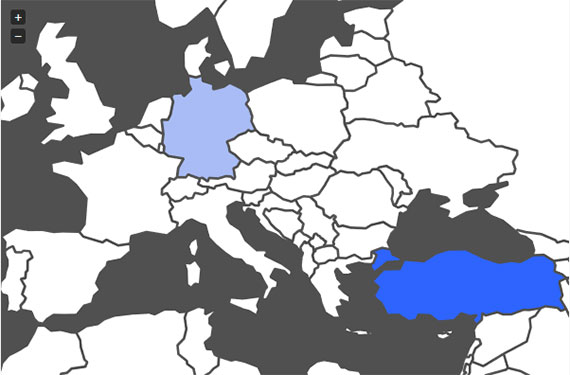Indiana University’s Department of Central Eurasian Studies (CEUS) offers students the chance to learn Turkish, a language spoken by over 63 million people, the language of a rising power in the Middle East and in the world, but one spoken by few outsiders. Every year, CEUS offers introductory, intermediate, and advanced Turkish classes taught by the IU Senior Lecturer in Turkish.
Turkish language study at IU

Turkish language learning as part of the CEUS undergraduate major and minor
Turkish is one of the languages available for the CEUS undergraduate major. Tracks with two or three years of language study are available.
Fulfill your foreign language requirement in a small class with dedicated teachers. You can also receive a CEUS minor with two years of Turkish language study and a related culture course.
IU Course Offerings:
Course offerings are made available in accordance with class level and student interest. Several IAUNRC languages - including Turkish - are part of IU’s Summer Language Workshop.
Why study Turkish?
Turkish is one of the ten languages on the critical language list for the US State Department and is important to the tech industry as well. Companies like Google, YouTube, Myspace, and other major companies all need Turkish speakers.
Turkish uses the Latin script and you can usually pronounce words correctly by their spelling. Turkish is an agglutinative language which has cases, but no gender or complex grammatical combinations. Word endings combine to give listeners tense, number and subject.
Turkish is the most widely spoken of the Turkic languages, with over 70 million native speakers. Speakers are located predominantly in Turkey, with smaller groups in Germany, Bulgaria, Macedonia, Northern Cyprus, Greece, and other parts of Eastern Europe, Caucasus and Central Asia. The roots of the language can be traced to Central Asia, with the first known written records dating back nearly 1,300 years. To the west, the influence of Ottoman Turkish—the variety of the Turkish language that was used as the administrative and literary language of the Ottoman Empire—spread as the Ottoman Empire expanded. In 1928, as one of Atatürk's Reforms in the early years of the Republic of Turkey, the Ottoman script was replaced with a Latin alphabet. Concurrently, the newly founded Turkish Language Association initiated a drive to reform and standardize the language.
Turkish Alphabet
A a /a/ As 'a' in father
B b /b/ As 'b' in boy
C c /dʒ/ As 'j' in joy
Ç ç /tʃ/ As 'ch' in champ
D d /d/ As 'd' in dog
E e /e/ As 'e' in red
F f /f/ As 'f' in far
G g /ɡ/, /ɟ/ As 'g' in got
Ğ ğ /uː/ Velar approximate
H h /h/ As 'h' in hot
I ı /ɯ/ As 'i' in cousin
İ i /i/ As 'ee' in feet
J j /ʒ/ As 's' in measure
K k /k/, /c/ As 'k' in kit
L l /ɫ/, /l/ As 'l' in love
M m /m/ As 'm' in man
N n /n/ As 'n' in nice
O o /o/ As 'o' in more
Ö ö /ø/ As 'i' in bird
P p /p/ As 'p' in pin
R r /r/ As 'r' in rat
S s /s/ As 's' in song
Ş ş /ʃ/ As 'sh' in show
T t /t/ As 't' in tick
U u /u/ As 'u' in bull
Ü ü /y/ As 'ue' in rue (fr.)
V v /v/ As 'v' in waver
Y y /j/ As 'y' in yes
Z z /z/ As 'z' in zigzag
Common Phrases:
Audio transcript:
Merhaba!
Hello!
Audio transcript:
Türkçe öğrenmeyi seviyorum!
I love learning Turkish!
Audio transcript:
Güle güle.
Goodbye.


